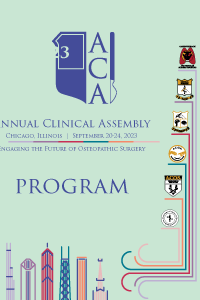General Surgery
Influences of Body Mass and Stature on Biometrics of the Greater Omentum
- LL
Liezel J. Lenhart
Pacific Northwest University of Health Sciences
Walla Walla, Washington, United States
Primary Presenter(s)
From neoangiogenesis to tissue regeneration and flap-based reconstruction, the greater omentum has been used in a variety of unlikely, but innovative ways in surgical research. This apron-shaped peritoneal tissue, spanning over the abdominal viscera, exhibits variability in its size and shape. Despite its surgical importance, the anatomy of the greater omentum has not been systematically characterized. Previously collected cadaveric omenta revealed statistical differences between sex and metrics of omental mass and volume. However, this data did not include weight, height, or BMI and the sample size was small. This research will continue to collect greater omenta metrics in order to increase sample size and further investigate the role of BMI in biometrics using cadaveric omenta and estimations of stature and body mass.
Methods or Case Description:
Greater omenta were collected from 30 embalmed cadavers from a medical school gross anatomy course. The cadaver ages ranged from 52 to 95 years old, with 17 females and 13 males. Once dissected from its attachments, omenta were photographed and weighed for mass and measured for volume. Measurements of the femoral head diameter (FHD) and maximum femoral length (MFL) were collected from each respective cadaver and used as input into the following equations: S=2.38×MFL+61.41 (males), S=2.47×MFL+54.10 (females), and BM=2.268×FHD-36.5. Cadaveric stature (S) represents an estimation of height. MFL is measured from the superior aspect of the femoral head to the inferior aspect of the medial condyle of femur. Cadaveric body mass (BM) represents an estimation of weight. FHD is measured from the distance anterior to posterior of the femoral head. Using estimated stature and body mass, BMI was calculated for each cadaver. Statistical analysis using R compared anatomical parameters with age, sex, estimated body mass, stature, and BMI using a student’s t-test and generalized linear model.
Outcomes:
Mean omental mass was 220.9 ± 194.8 g with a range of 33.9 to 759.4 g. Mean omental volume was 215 ± 160 ml with range of 30 to 640 ml. Mean femur length was 45.2 ± 3.2 cm with a range of 39.6 to 51.1 cm. Mean femoral head diameter was 47.2 ± 4.7 mm with a range of 40.2 to 55.0 mm. Mean estimated stature was 167.0 ± 9.2 cm with a range of 151.9 to 183.0 cm. Mean estimated body mass was 70.5 ± 10.7 kg with a range of 54.6 to 88.2 kg. Mean calculated BMI was 25.1 ± 1.8 kg/m2 with a range of 21.8 to 29.0 kg/m2. Mass and volume demonstrated statistically significant differences between females and males (P < 0.05). Estimated body mass, stature, and BMI demonstrated statistical differences between females and males (P < 0.05). Omental mass and volume demonstrated a positive correlation with estimated stature regardless of sex. Omental mass and volume demonstrated no correlation with estimated body mass and BMI. Age demonstrated no correlation with omental mass or volume regardless of sex.
Conclusion:
Since initial research regarding the anatomy of the greater omentum in 1980s, there has not been a systematic survey of omental biometrics. This research has collected biometrics on cadavers to better characterize omental morphology and size and to study factors that may alter these dimensions. Studies currently deduce that BMI plays a role in omental biometrics. Unfortunately, height, weight, and BMI were unavailable from the cadavers in this study. Thus, this research used published equations that utilize femoral measurements to calculate body mass and stature, which assume a biomechanical relationship upon the skeleton. No correlation was found between estimated body mass and associated BMI, but rather omental mass and volume were positively correlated with the estimated height of cadaver. Possible disagreements with previously published findings could be attributed to the fixation process, elderly cadavers, unknown abdominal medical or surgical history, small sample size, and sample population differences. Future studies aim to validate cadaveric height with estimated stature as well as increase sample size of omental, body mass, and stature measurements. Delineating the factors that influence omental biometrics will provide better prediction of omental size for surgical uses prior to operation. In addition, gathering biometrics of greater omenta is important for understanding different morphologies and functions and promotes future studies of the greater omentum in medical and surgical applications.

